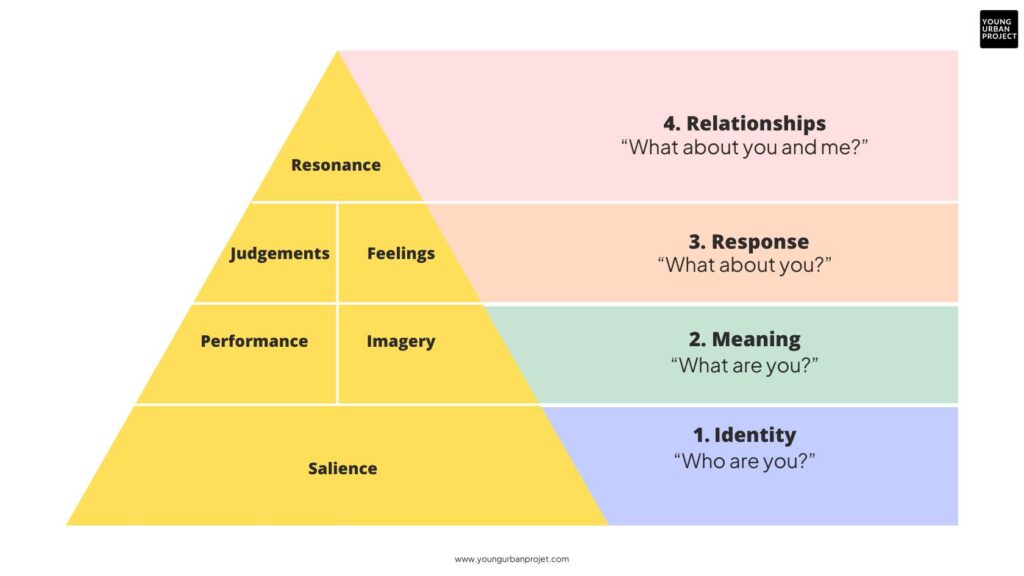A customer walks into a grocery store to buy butter. He bypasses 5 other options and heads straight for Amul butter. No hesitation, no second-guessing. Why? Because Amul isn’t just a name—it’s a promise, a feeling, and a trusted companion.
Table of Contents
Now this phenomenon doesn’t happen overnight. It’s the result of carefully crafted brand equity, and one of the most effective frameworks to understand and build it is Keller’s Brand Equity Model. Created by marketing expert Kevin Lane Keller, this model offers a step-by-step guide to creating a brand that’s not just known but loved.
Whether you’re a business owner, marketer, or brand strategist, mastering this model could be your key to long-term success. Let’s break it down: what brand equity is, what Keller’s model entails, how you can use it, and why it matters more than ever.
What Is Brand Equity?
Brand equity is the intangible value a brand adds to a product or service. It’s the reason people pay more for the same quality product because it carries a trusted name. This isn’t just about recognition—it’s about the emotional and functional benefits a brand represents.
Why Does Brand Equity Matter?
- Higher Profit Margins
- Strong brands justify premium pricing, giving them a competitive edge.
- Increased Customer Loyalty
- Customers who trust your brand are more likely to return.
- Stronger Negotiation Power
- Whether it’s with suppliers, distributors, or partners, a strong brand gives you leverage.
- Crisis Resilience
- Brands with loyal customers recover faster during PR or market crises.
Examples of Strong Brand Equity
- Patagonia: Known for its eco-conscious values, customers buy into the brand’s mission, not just its products.
- LEGO: The brand isn’t just about toys; it’s about creativity, learning, and nostalgia for generations of users.
- Spotify: Dominating the music streaming space by combining innovation with a personalized user experience.
What Is Keller’s Brand Equity Model?
Kevin Lane Keller’s Brand Equity Model, also known as the Customer-Based Brand Equity (CBBE) Model, provides a structured framework for understanding how to build a brand that resonates deeply with customers.
This model is often visualized as a pyramid with four progressive levels, each focusing on a different aspect of the customer-brand relationship. The pinnacle of this pyramid is brand resonance, where customers are not just buyers but advocates.

The Four Levels of Keller’s Brand Equity Model
1. Brand Identity: Who Are You?
The foundation of the pyramid is ensuring customers know who you are and what you stand for. This is about building awareness and recognition.
- Key Metric: Brand salience, which measures the frequency and ease of recall.
- Example: Zoom became synonymous with virtual meetings during the pandemic because it was immediately recognizable and easy to use.
- Tips:
- Create a memorable logo and tagline.
- Maintain consistency in branding across all platforms.
2. Brand Meaning: What Are You?
Once customers recognize your brand, the focus shifts to what your brand represents. Keller breaks this level into two components:
- Performance: How well your product or service meets customers’ functional needs.
- Imagery: The emotions and associations tied to your brand.
- Example: Oatly doesn’t just sell oat milk; it sells sustainability, health, and a quirky, rebellious attitude through its branding and packaging.
- Tips:
- Use storytelling to emphasize your brand’s unique value.
- Create a lifestyle image around your product.
3. Brand Response: What About You?
At this stage, focus on how customers perceive and evaluate your brand, both rationally and emotionally.
- Judgments: Rational assessments, such as quality, credibility, and superiority.
- Feelings: Emotional responses, such as happiness, pride, or nostalgia.
- Example: Dyson is judged on innovation and superior performance, while brands like Ben & Jerry’s evoke feelings of joy and social consciousness.
- Tips:
- Encourage positive reviews and testimonials.
- Launch campaigns that tap into customer emotions.
4. Brand Resonance: What About You and Me?
The pinnacle of Keller’s pyramid is brand resonance, where customers become loyal advocates and actively engage with your brand.
- Example: Fender, the guitar brand, has a cult following of musicians who not only buy their instruments but participate in Fender-sponsored events and tutorials.
- Key Components:
- Behavioral loyalty (repeat purchases).
- Emotional attachment (customers feel connected to the brand).
- Active engagement (social media, communities, or events).
Real-World Examples
- Harley-Davidson achieves resonance through a sense of community among riders, fostering loyalty and emotional attachment.
- Tesla exemplifies a combination of performance (sustainability, innovation) and strong emotional appeal, achieving advocacy from loyal customers who identify with its vision.

How to Use Keller’s Brand Equity Model Effectively
Keller’s Brand Equity Model, also known as the Customer-Based Brand Equity (CBBE) model, provides a systematic approach to building strong brands by fostering meaningful relationships with customers. Its pyramid structure has four levels: brand identity, brand meaning, brand response, and brand resonance. Each level is crucial in nurturing customer loyalty and driving long-term brand success.
Step 1: Establish Brand Identity (Salience)
At the pyramid’s base, salience represents brand awareness. Start by ensuring your target audience can easily recognize and recall your brand. Key actions include:
- Researching your audience to understand their pain points and preferences.
- Crafting a clear and consistent message across marketing platforms.
- Using distinctive logos, taglines, and visuals to strengthen brand recall.
This stage ensures your audience knows what your brand represents and associates it with their needs and desires.
Step 2: Build Brand Meaning (Performance and Imagery)
The second level involves shaping how your brand is perceived. It comprises two components:
- Performance: Ensure your products/services deliver on their promises. This includes aspects like functionality, reliability, durability, and customer satisfaction. Positive experiences enhance trust and credibility.
- Imagery: Appeal to customers’ social and psychological needs. Define your brand’s personality—whether it’s quirky, sophisticated, or environmentally conscious—and reflect this in your marketing. Align your imagery with your audience’s values to foster emotional connections.
For example, brands like Patagonia leverage their eco-conscious identity to connect with environmentally aware consumers.
Step 3: Elicit Brand Response (Judgments and Feelings)
At this level, you aim to influence customers’ evaluations and emotional responses to your brand:
- Judgments: Focus on building a reputation for quality, credibility, and superiority over competitors. For instance, premium brands like Tesla emphasize innovation and sustainability to reinforce their superiority.
- Feelings: Evoke positive emotions such as trust, pride, or excitement through storytelling and exceptional customer service.
Consistency in delivering value helps create a favorable image, prompting customers to prefer your brand over others.
Step 4: Achieve Brand Resonance
At the pyramid’s peak lies brand resonance, the ultimate goal. This represents a deep psychological connection with your audience, manifesting as loyalty, advocacy, and a sense of community. To achieve this:
- Create experiences that foster a sense of belonging, such as loyalty programs or exclusive events.
- Encourage active engagement through interactive campaigns and social media.
Brands like Harley-Davidson excel here by nurturing communities of passionate users who identify with the brand.
Also read: What is Quick Commerce: The Ultimate Guide
Why Use Keller’s Brand Equity Model?
Keller’s Brand Equity Model offers a robust framework for businesses to systematically build, evaluate, and manage their brand equity. Its strategic insights are invaluable for companies seeking to foster meaningful customer relationships, establish market differentiation, and ensure long-term growth. Here’s a deeper look into why this model is a powerful tool for brands:
1. Focus on Customer-Centricity
At its core, Keller’s model emphasizes the customer’s perspective, making it highly relevant in a competitive, consumer-driven market. It prioritizes understanding how customers perceive and interact with a brand, ensuring that all branding efforts align with their needs, preferences, and emotions. This customer-first approach helps businesses create products and experiences that resonate deeply, enhancing loyalty and advocacy.
2. Systematic Approach to Building Brand Equity
The model’s pyramid structure offers a step-by-step guide to strengthen brand equity:
- Foundation: Establishing awareness ensures potential customers can recognize and recall the brand effortlessly.
- Mid-level: Developing brand meaning helps differentiate the brand through tangible attributes (performance) and emotional appeal (imagery).
- Peak: Cultivating brand resonance leads to loyal customers who act as brand ambassadors.
This systematic progression ensures a holistic approach, covering every aspect of the customer journey, from initial awareness to deep emotional connection.
3. Versatility Across Industries
One of the model’s greatest strengths is its adaptability. Whether you’re running a tech startup, managing a luxury brand, or leading a nonprofit, Keller’s model provides actionable insights. It works for brands at different stages of their lifecycle, from building awareness in nascent stages to enhancing resonance in mature markets.
For instance:
- A small eco-friendly skincare company can use it to establish a strong identity tied to sustainability and create lasting emotional bonds with environmentally conscious consumers.
- An established sports brand can refine its resonance by focusing on community-building activities like events or sponsorships.
4. Practical Tool for Decision-Making
Keller’s model is not just a theoretical concept; it serves as a practical decision-making framework. Businesses can use it to:
- Evaluate Performance: Identify strengths and weaknesses across the pyramid levels (e.g., low awareness or weak emotional connection).
- Prioritize Resources: Allocate resources effectively to address specific gaps, such as investing in brand awareness campaigns or enhancing customer experiences.
- Guide Marketing Strategy: Align marketing efforts with brand goals, whether it’s improving functionality, reinforcing brand values, or building loyalty programs.
5. Enhances Competitive Advantage
In crowded markets, differentiation is key. Keller’s model helps brands establish a unique identity and meaning, which distinguishes them from competitors. For example:
- Brand Performance: Highlighting superior product features can attract quality-conscious consumers.
- Brand Imagery: Aligning with cultural or social values creates a strong emotional appeal.
These differentiators not only attract customers but also create a compelling reason for them to remain loyal.
6. Aligns Short-Term Actions with Long-Term Goals
While many marketing strategies focus on immediate results, Keller’s model balances short-term objectives with long-term brand equity building. It reminds businesses to:
- Deliver consistently on promises (performance).
- Build emotional connections that foster loyalty and advocacy.
- Focus on resonance to ensure customers feel an enduring relationship with the brand.
This long-term view helps businesses build sustainable success rather than relying on temporary tactics.
7. Provides a Benchmark for Success
Using Keller’s model, businesses can track their progress in building brand equity. Each level of the pyramid serves as a benchmark for evaluating success. For example:
- Improved customer recall and recognition indicate success in salience.
- Positive word-of-mouth and repeat purchases reflect strong resonance.
By measuring progress at each level, companies can make informed decisions to refine their strategies.
8. Promotes a Unified Brand Strategy
The model encourages cross-departmental alignment, ensuring that marketing, sales, customer service, and product development efforts work cohesively. For instance:
- Marketing teams can focus on crafting campaigns that build emotional resonance.
- Customer service teams can address performance and satisfaction.
- Product teams can align features with customer expectations.
This holistic approach ensures a consistent brand message and experience across touchpoints.
9. Applicable in the Digital Age
In today’s digital landscape, the principles of Keller’s model are more relevant than ever. Brands can leverage digital tools to:
- Boost Salience: Use SEO, social media, and influencer partnerships to enhance visibility.
- Enhance Performance: Gather real-time feedback through reviews and improve product features.
- Build Resonance: Foster online communities and engage audiences with interactive content.
Digital platforms also make it easier to measure the effectiveness of strategies across different levels of the pyramid.
10. Supports Financial Growth
Finally, a strong brand equity built using Keller’s model translates directly into financial gains. Loyal customers are more likely to:
- Pay premium prices for trusted brands.
- Recommend the brand to others, reducing acquisition costs.
- Provide repeat business, ensuring steady revenue streams.
For example, a robust resonance level ensures that customers remain committed even in competitive markets, providing a stable base for growth.
Also Read: The Importance of Marketing in Business
Conclusion
Building strong brand equity is not just about selling a product; it’s about creating an experience, a connection, and a lasting relationship. With Keller’s Brand Equity Model, you have a roadmap to guide your brand from basic recognition to deep customer loyalty.
Whether you’re a startup looking to stand out or an established brand aiming to deepen your connection with customers, this framework is your key to success. So, take a moment to evaluate: where does your brand sit on Keller’s pyramid? And what steps can you take today to climb higher?
The journey to brand resonance is challenging but transformative. And when you get it right, you won’t just have customers—you’ll have lifelong advocates.
FAQs: Keller’s Brand Equity Model
1. What is Keller’s Brand Equity Model?
Keller’s Brand Equity Model, also known as the Customer-Based Brand Equity (CBBE) model, provides a structured approach to building strong brands by focusing on customer perceptions and relationships. It explains that brand equity is built when customers feel a deep emotional connection to the brand. The model is represented as a pyramid with four key levels: brand identity (who you are), brand meaning (what you stand for), brand response (how customers react to you), and brand resonance (the ultimate level of loyalty and engagement). Each level builds on the previous one, emphasizing the importance of a step-by-step process in creating a strong and lasting brand.
2. Why is Keller’s Brand Equity Model important?
This model is important because it shifts the focus to customers, emphasizing their perceptions and emotions as the foundation of brand equity. By following the framework, businesses can create a clear brand identity, differentiate themselves in competitive markets, and build meaningful relationships with their audience. This, in turn, fosters loyalty and advocacy, which are crucial for long-term success. In a world where customers have countless choices, Keller’s model offers a strategic roadmap to stand out and connect with customers on a deeper level.
3. What are the core levels in the Keller’s Brand Equity Model?
The model consists of four stages arranged in a pyramid:
–Brand Identity (Recognition): At the base of the pyramid, this level focuses on ensuring customers can identify and recognize the brand. It’s about building awareness and establishing who you are.
–Brand Meaning (Functional and Emotional Associations): This level focuses on defining what the brand stands for through functional benefits (what the product does) and emotional values (how it makes customers feel).
–Brand Response (Judgments and Feelings): Here, the model evaluates how customers perceive the brand, both rationally (judgments) and emotionally (feelings).
–Brand Resonance (Connection): The pinnacle of the pyramid, this stage is about creating deep, meaningful relationships where customers feel a strong attachment and loyalty to the brand.
4. How can Keller’s Brand Equity Model be applied?
To apply this model, businesses should take a step-by-step approach:
–Build awareness (Identity): Use consistent branding and messaging to ensure customers recognize your brand across all touchpoints.
–Define what you stand for (Meaning): Highlight the functional benefits of your product or service while incorporating emotional storytelling to build an emotional connection.
–Shape perceptions (Response): Gather customer feedback to understand how they view your brand. Use this information to fine-tune your offerings and communication.
–Deepen relationships (Resonance): Engage customers through personalized experiences, loyalty programs, and community-building efforts to foster long-term connections.
By systematically addressing these steps, businesses can create a brand that customers trust, value, and actively engage with.
5. Does Keller’s Brand Equity Model work for small businesses?
Absolutely! Keller’s model is highly adaptable, making it ideal for businesses of all sizes, including small businesses. Small businesses can use the framework to carve out a niche by creating a strong identity and connecting emotionally with their target audience. For instance, even with limited resources, small businesses can leverage social media for brand recognition, tell authentic stories to convey meaning, and build loyalty by offering personalized experiences or rewards for repeat customers. This step-by-step approach ensures that small businesses can compete effectively in their markets.
6. Is the Keller’s brand equity model relevant for digital marketing?
Yes, Keller’s Brand Equity Model is very relevant in the digital age. Each stage of the model aligns perfectly with digital marketing strategies:
–Brand Identity: SEO and consistent branding across digital platforms can boost recognition.
–Brand Meaning: Storytelling through blogs, videos, and social media posts helps convey functional benefits and emotional values.
–Brand Response: Social media, reviews, and surveys allow businesses to understand customer judgments and feelings.
–Brand Resonance: Community-building efforts like Facebook groups, loyalty programs, or email marketing campaigns foster long-term relationships.
The model complements digital strategies by focusing on building strong connections that can translate into online engagement and advocacy.
7. How does Keller’s brand equity model differ from Aaker’s model?
While both models focus on brand equity, their approaches differ significantly:
Keller’s model is customer-centric. It prioritizes building relationships and emotional connections with customers.
Aaker’s model is asset-focused. It emphasizes the financial value of brand elements, such as brand awareness, loyalty, and perceived quality.
In simpler terms, Keller’s model provides a practical roadmap for creating strong customer relationships, making it particularly useful for businesses looking to enhance customer loyalty. Aaker’s model, on the other hand, is more strategic for evaluating and managing the financial strength of a brand. Both models are valuable, but the choice depends on the specific goals of the business.

